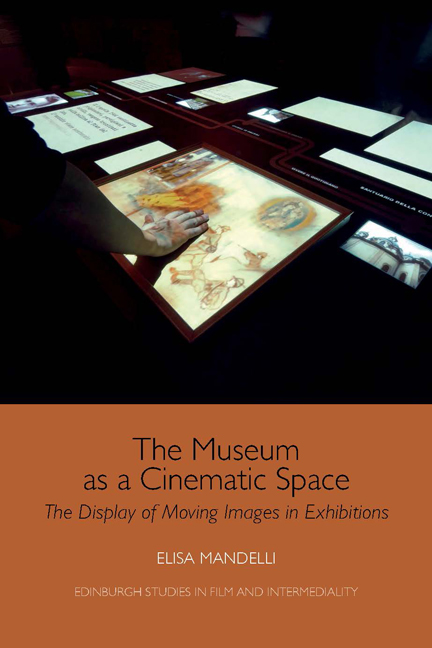Book contents
- Frontmatter
- Contents
- List of Figures
- Acknowledgements
- Preface
- Introduction
- Part I Between History and Modernity: Films in Exhibitions in the Twentieth Century
- 1 Cinema, Museums, Memory and Education
- 2 ‘A dimly-lighted corner’: Moving Images in Museums in the First Decades of the Twentieth Century
- 3 Moving Images in Museums, World's Fairs and Avant-garde Exhibition Design
- 4 The Multi-media Museum: The 1960s–70s
- Part II The Museum as a Cinematic Space: Museums and Moving Images in the Twenty-first Century
- Conclusions
- Bibliography
- Index
3 - Moving Images in Museums, World's Fairs and Avant-garde Exhibition Design
from Part I - Between History and Modernity: Films in Exhibitions in the Twentieth Century
Published online by Cambridge University Press: 24 October 2019
- Frontmatter
- Contents
- List of Figures
- Acknowledgements
- Preface
- Introduction
- Part I Between History and Modernity: Films in Exhibitions in the Twentieth Century
- 1 Cinema, Museums, Memory and Education
- 2 ‘A dimly-lighted corner’: Moving Images in Museums in the First Decades of the Twentieth Century
- 3 Moving Images in Museums, World's Fairs and Avant-garde Exhibition Design
- 4 The Multi-media Museum: The 1960s–70s
- Part II The Museum as a Cinematic Space: Museums and Moving Images in the Twenty-first Century
- Conclusions
- Bibliography
- Index
Summary
TWENTIETH-CENTURY AVANT-GARDES AND EXHIBITION DESIGN
During the 1920s and the 1930s, the artistic avant-gardes experimented with various cinematic and exhibition dispositifs. Persuaded of the interpenetration between art and life and of the necessity to overcome the practice of art for art's sake, avant-garde artists such as El Lissitzky, Frederick Kiesler, and László Moholy-Nagy, as well as Bauhaus members such as Herbert Bayer, Walter Gropius, and Mies van der Rohe, were active in a variety of sectors such as typography, graphic or furniture design, advertising, and exhibition design.
These artists and architects designed not only museum galleries, but also and especially educational exhibitions that began to flourish in Germany in the 1920s. Janet Ward speaks of an ‘exhibition mania’, an economic and symbolic desire to show to the international community the new modern face of Germany. An Ausstellungspolitik (exhibition policy) was established, which led to the creation of a great number of exhibitions, in Berlin and throughout Germany, on the most heterogeneous topics related to technology, industry, or the needs of social life: cars, clothing, furniture, radio, photography and cinema, hygiene and health.
Although didactic exhibitions belonged to the nineteenth-century tradition of fairs and universal exhibitions, their main concern was not so much to present singular objects as to communicate ideas, composing, as Olivier Lugon states, ‘argumentative or narrative structures, logical developments or emotional sequences in which each exhibit had to find its place’. Working in these contexts, avant-garde artists were free from the institutional codes and regulations of the art field, and developed some of the most interesting and ground-breaking solutions in exhibition design.
The contribution of avant-garde artists was two-fold. First, they tested new ways of integrating moving images with other display solutions, such as diagrams, charts, lights, photographs, and panels. Second, they contributed to rethinking the exhibition as a complex and dynamic system articulated across multiple media. Such a system was supposed to be able to attract visitors by means of visual effects, orchestrate their perception and movements by means of its spatial arrangement and, if necessary, elicit a direct interaction. Significantly, scholars such as Lugon have noted that even when films were not included in the exhibitions, the spatial configuration of avant-garde exhibition displays was animated by an intrinsically cinematic and dynamic principle.
- Type
- Chapter
- Information
- The Museum as a Cinematic SpaceThe Display of Moving Images in Exhibitions, pp. 46 - 60Publisher: Edinburgh University PressPrint publication year: 2019



